
The British Rail Class 47 or Brush Type 4 is a class of diesel-electric locomotive that was developed in the 1960s by Brush Traction. A total of 512 Class 47s were built at Brush's Falcon Works in Loughborough and at British Railways' Crewe Works between 1962 and 1968, which made them the most numerous class of British mainline diesel locomotive.

The British Rail Class 37 is a diesel–electric locomotive. Also known as the English Electric Type 3, the class was ordered as part of the British Rail modernisation plan. They were numbered in two series, D6600–D6608 and D6700–D6999.

In rail transport, head-end power (HEP), also known as electric train supply (ETS), is the electrical power distribution system on a passenger train. The power source, usually a locomotive at the front or 'head' of a train, provides the electricity used for heating, lighting, electrical and other 'hotel' needs. The maritime equivalent is hotel electric power. A successful attempt by the London, Brighton and South Coast Railway in October 1881 to light the passenger cars on the London to Brighton route heralded the beginning of using electricity to light trains in the world.

The British Rail Class 90 is a type of electric locomotive. They were built for mixed-traffic duties, operating from 25 kV AC overhead lines and producing 5,000 bhp (3,700 kW). They weigh 84.5 tonnes and can typically achieve a top speed of 110 mph (177 km/h).

The British Rail Class 60 is a class of Co-Co heavy freight diesel-electric locomotives built by Brush Traction. They are nicknamed Tugs by rail enthusiasts.
Originally, both Deutsche Bundesbahn and Deutsche Reichsbahn continued the classification system of the Deutsche Reichsbahn (DRG) – see also a short overview of the numbering system of the German railways. When UIC introduced a new classification system that could be processed by the computers of the late 1960s, DB did a major modification of their system, effective 1 January 1968. This system is still in use and now includes the engines of the former GDR railways as well.

St Blazey engine shed is located in Par, Cornwall, United Kingdom, although it is named after the adjacent village of St Blazey. It was built in 1874 as the headquarters of the Cornwall Minerals Railway but for many years was a depot of the Great Western Railway. The current depot operator is DB Cargo and the depot TOPS code is BZ.

The British Rail Class 48 was a diesel locomotive class which consisted of five examples, built at Brush Falcon Works in Loughborough and delivered between September 1965 and July 1966. They were part of the British Rail Class 47 order, but differed from their classmates by being fitted with a Sulzer V12 12LVA24 power unit producing 2,650 bhp (1,976 kW), as opposed to the standard 12LDA28C twin-bank twelve-cylinder unit of the remaining fleet.
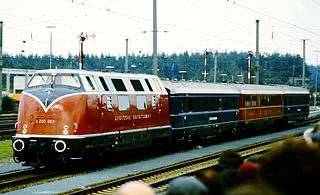
DB Class V 200 was the first series production diesel-hydraulic express locomotive of the German Deutsche Bundesbahn and – as Am 4/4 – of the SBB-CFF-FFS in Switzerland.

The Class DE10 (DE10形) is a class of Japanese C-B wheel arrangement diesel-hydraulic locomotives. 708 locomotives were built between 1966 and 1978. As of 1 April 2016, 138 locomotives remained in operation.
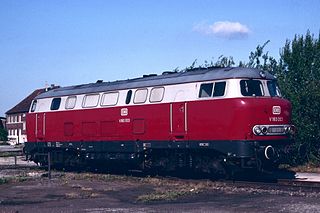
The Class V 160 is a class of diesel-hydraulic locomotives of the German railways. It is the first variant of the V160 family, built for the Deutsche Bundesbahn for medium/heavy trains.
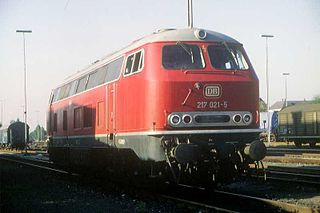
The DB Class V 162 is a class of four-axle diesel hydraulic locomotive built as a development of the DB Class V 160 for the Deutsche Bundesbahn from 1965 to 1968.

The DB Class 215 is a 4 axle diesel locomotive of the V 160 type. They were built for the German Federal Railways for medium-weight passenger and freight service on secondary and primary routes, and later passed to the Deutsche Bahn AG.

The DB Class 218 are a class of 4-axle, diesel-hydraulic locomotives acquired by the Deutsche Bundesbahn for use on main and secondary lines for both passenger and freight trains.
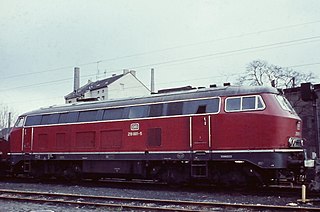
The DB Class V 169 consisted of a single example: V 169 001, derived from the DB Class V 160 family, with an additional gas turbine booster engine. It can be considered the prototype for diesel locomotives with a gas turbine as an additional drive; specifically the DB Class 210. Post 1968 the class designation was changed to Class 219, and the locomotive renumbered 219 001
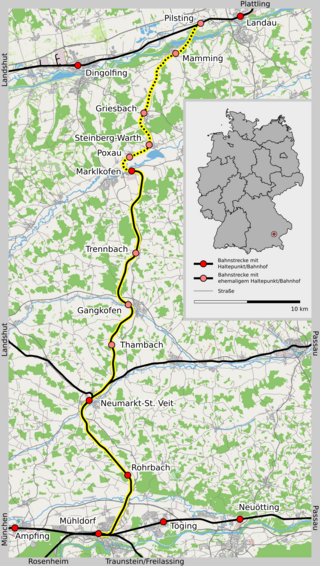
The Mühldorf–Pilsting railway runs mainly through the province of Lower Bavaria in Germany, but part of the line crosses into Upper Bavaria as well. It was opened in 1875 by the Bavarian Eastern Railway Company as part of the route between Mühldorf and Plattling, and was taken over by the Royal Bavarian State Railways on 1 January 1876. Whilst the southern section of the route from Mühldorf to Neumarkt-Sankt Veit became an important regional transport link as a result of the branches to Landshut and Passau at Neumarkt-Sankt Veit, the remaining section of the line never achieved its expected significance. Since 1970 only goods trains have worked between Neumarkt-Sankt Veit and Frontenhausen-Marklkofen, the adjoining section to Pilsting was closed entirely in 1969.
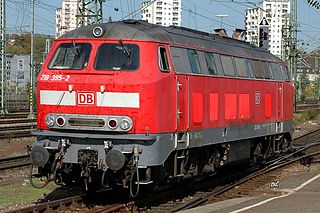
The DB V 160 locomotive family comprises several classes of closely related 4-axle diesel-hydraulic locomotives built in the 1960s and 1970s for the Deutsche Bundesbahn which take the family name from the earliest built model: the 'DB Class V 160'.
The Mühldorf–Simbach am Inn railway is a 39 km long, single-tracked, unelectrified main line in Bavaria in southern Germany.
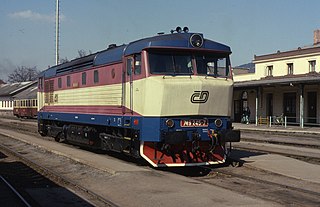
The ČD 749 class is a diesel electric locomotive, created through refurbishment of classes 751 and 752.

T478.3 is a class of locomotives built for Czechoslovak State Railways to replace the most powerful steam locomotives in heavy passenger and freight service. Their design is based on the type T478.1; the main difference is the new, more powerful V12 diesel engine.



















